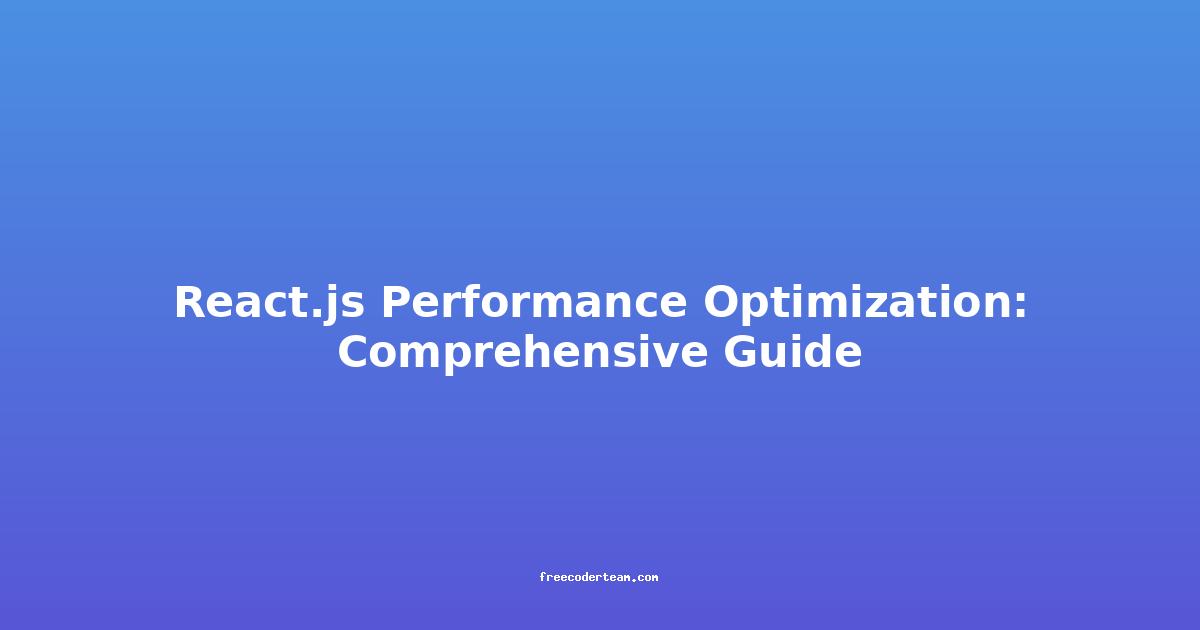React.js Performance Optimization: A Comprehensive Guide
React.js has become one of the most popular JavaScript libraries for building user interfaces, thanks to its component-based architecture and virtual DOM. However, as your application grows in complexity, performance can become a concern. In this comprehensive guide, we'll explore various techniques and best practices to optimize React applications for better performance. We'll cover everything from rendering optimization to state management and beyond.
Table of Contents
- Understanding Performance Bottlenecks
- Optimizing Component Rendering
- Efficient State Management
- Avoiding Unnecessary Re-renders
- Optimizing Large Lists
- Lazy Loading with Code Splitting
- Performance Profiling and Tools
- Conclusion
Understanding Performance Bottlenecks
Before diving into optimization techniques, it's essential to understand what causes performance bottlenecks in React applications:
- Excessive Re-renders: Components re-rendering unnecessarily can lead to performance degradation, especially in large applications.
- Large Data Sets: Rendering large lists or handling massive data sets can slow down the application.
- Redundant State Updates: Frequent, unnecessary state changes can trigger excessive re-renders.
- Third-Party Libraries: Overuse or misconfiguration of third-party libraries can add overhead.
By addressing these bottlenecks, you can significantly improve your application's performance.
Optimizing Component Rendering
Memoization with React.memo
React.memo is a higher-order component (HOC) that memoizes functional components, preventing them from re-rendering unless their props change. This is particularly useful for pure components that don't have internal state.
Example: Using React.memo
import React from 'react';
const MyComponent = React.memo(({ count }) => {
console.log('Rendering MyComponent');
return <div>{count}</div>;
});
function App() {
const [count, setCount] = React.useState(0);
return (
<div>
<button onClick={() => setCount(count + 1)}>Increment</button>
<MyComponent count={count} />
</div>
);
}
export default App;
In this example, MyComponent will only re-render when the count prop changes.
PureComponent vs. React.memo
While React.memo is similar to PureComponent, it has some key differences:
- PureComponent: Works with class components and performs a shallow prop comparison.
- React.memo: Works with functional components and also performs a shallow prop comparison.
For functional components, React.memo is the preferred choice.
React Keys for Efficient Updates
React uses keys to identify which items have changed, been added, or been removed. Without proper keys, React may re-render the entire list instead of just the changed items.
Example: Using Keys
import React from 'react';
function App() {
const [items, setItems] = React.useState([1, 2, 3]);
return (
<ul>
{items.map((item) => (
<li key={item}>{item}</li>
))}
</ul>
);
}
export default App;
Here, each list item is given a unique key (item), allowing React to efficiently update only the changed items.
Efficient State Management
Minimize Redundant State Updates
Frequent state updates can trigger excessive re-renders. To minimize this, use useState wisely and avoid unnecessary re-renders.
Example: Preventing Redundant Updates
import React, { useState } from 'react';
function App() {
const [count, setCount] = useState(0);
// Prevent redundant updates
const increment = () => {
setCount((prevCount) => prevCount + 1);
};
return (
<div>
<button onClick={increment}>Increment</button>
<div>Count: {count}</div>
</div>
);
}
export default App;
Using a functional update ((prevCount) => prevCount + 1) ensures that the state is updated only when necessary.
Using Context for Global State
For global state management, React's Context API is a lightweight alternative to third-party libraries like Redux. It avoids unnecessary re-renders by ensuring that only the components that depend on the context re-render.
Example: Using Context
import React, { createContext, useContext, useState } from 'react';
const ThemeContext = createContext();
function ThemeProvider({ children }) {
const [theme, setTheme] = useState('light');
return (
<ThemeContext.Provider value={{ theme, setTheme }}>
{children}
</ThemeContext.Provider>
);
}
function ThemeToggler() {
const { theme, setTheme } = useContext(ThemeContext);
return <button onClick={() => setTheme(theme === 'light' ? 'dark' : 'light')}>Toggle Theme</button>;
}
function App() {
return (
<ThemeProvider>
<ThemeToggler />
</ThemeProvider>
);
}
export default App;
This setup ensures that only components using the ThemeContext re-render when the theme changes.
Avoiding Unnecessary Re-renders
Lifting State Up
Sometimes, components re-render unnecessarily because they depend on state that could be managed at a higher level. Lifting state up to a common ancestor can prevent this.
Example: Lifting State Up
import React, { useState } from 'react';
const ChildComponent = ({ value, onChange }) => {
return <input value={value} onChange={onChange} />;
};
function App() {
const [value, setValue] = useState('');
return (
<div>
<ChildComponent value={value} onChange={(e) => setValue(e.target.value)} />
<div>Value: {value}</div>
</div>
);
}
export default App;
By managing the state at the App level, the ChildComponent only re-renders when necessary.
Memoizing Props with useMemo
The useMemo hook memoizes expensive computations or props, ensuring they are only recalculated when their dependencies change.
Example: Using useMemo
import React, { useMemo } from 'react';
function ComplexComponent({ data }) {
const processedData = useMemo(() => {
console.log('Processing data...');
return data.map((item) => item * 2);
}, [data]);
return <div>{processedData.join(', ')}</div>;
}
function App() {
const [data, setData] = React.useState([1, 2, 3]);
return (
<div>
<button onClick={() => setData([...data, data.length + 1])}>Add Data</button>
<ComplexComponent data={data} />
</div>
);
}
export default App;
Here, processedData is only recalculated when data changes.
Memoizing Functions with useCallback
The useCallback hook memoizes functions, ensuring they remain stable between re-renders. This is particularly useful when passing callbacks to child components that rely on reference equality.
Example: Using useCallback
import React, { useCallback } from 'react';
const ChildComponent = React.memo(({ onClick }) => {
console.log('Rendering ChildComponent');
return <button onClick={onClick}>Click Me</button>;
});
function App() {
const [count, setCount] = React.useState(0);
const handleClick = useCallback(() => {
setCount(count + 1);
}, [count]);
return (
<div>
<ChildComponent onClick={handleClick} />
<div>Count: {count}</div>
</div>
);
}
export default App;
By memoizing the handleClick function with useCallback, we ensure that ChildComponent only re-renders when necessary.
Optimizing Large Lists
React Virtualization
React Virtualization is a library that allows you to render only the visible portion of a large list, significantly improving performance. It works by rendering only the items that are visible in the viewport.
Example: Using react-virtualized
import React from 'react';
import { List } from 'react-virtualized';
function App() {
const rowRenderer = ({ index, key, style }) => (
<div key={key} style={style}>
Item {index}
</div>
);
return (
<div>
<List
width={300}
height={300}
rowCount={10000}
rowHeight={30}
rowRenderer={rowRenderer}
/>
</div>
);
}
export default App;
This example renders 10,000 items efficiently by only rendering the visible ones.
Windowing Techniques
Another approach to handling large lists is to use windowing techniques, where you render only a subset of items at a time based on the user's scroll position.
Example: Windowing Technique
import React, { useState, useEffect } from 'react';
function App() {
const [data, setData] = useState(Array.from({ length: 10000 }, (_, i) => i));
const [visibleItems, setVisibleItems] = useState([]);
const [startIndex, setStartIndex] = useState(0);
const handleScroll = () => {
const scrollTop = document.documentElement.scrollTop || document.body.scrollTop;
const itemsPerPage = 100;
const newStartIndex = Math.floor(scrollTop / 30); // Adjust based on item height
setStartIndex(newStartIndex);
setVisibleItems(data.slice(newStartIndex, newStartIndex + itemsPerPage));
};
useEffect(() => {
window.addEventListener('scroll', handleScroll);
return () => window.removeEventListener('scroll', handleScroll);
}, []);
return (
<div style={{ height: '20000px' }}>
{visibleItems.map((item) => (
<div key={item}>Item {item}</div>
))}
</div>
);
}
export default App;
This example renders only a subset of items based on the user's scroll position.
Lazy Loading with Code Splitting
Code Splitting with React Router
React Router's Suspense and lazy features allow you to load components dynamically, improving initial load times and reducing bundle size.
Example: Code Splitting with React Router
import React, { lazy, Suspense } from 'react';
import { BrowserRouter as Router, Routes, Route } from 'react-router-dom';
const Home = lazy(() => import('./Home'));
const About = lazy(() => import('./About'));
function App() {
return (
<Router>
<Suspense fallback={<div>Loading...</div>}>
<Routes>
<Route path="/" element={<Home />} />
<Route path="/about" element={<About />} />
</Routes>
</Suspense>
</Router>
);
}
export default App;
Here, Home and About are loaded dynamically as the user navigates to their respective routes.
Dynamic Imports
Dynamic imports can also be used to load components on demand, further optimizing performance.
Example: Dynamic Import
import React, { useState, useEffect } from 'react';
function App() {
const [Component, setComponent] = useState(null);
useEffect(() => {
import('./DynamicComponent').then((module) => {
setComponent(module.default);
});
}, []);
return (
<div>
{Component ? <Component /> : 'Loading...'}
</div>
);
}
export default App;
This example dynamically imports a component when needed.
Performance Profiling and Tools
React DevTools Profiler
The React DevTools Profiler is a powerful tool for identifying performance bottlenecks. It allows you to track render times, identify unnecessary re-renders, and optimize your application.
How to Use the Profiler:
- Open the React DevTools in your browser.
- Click on the "Components" tab.
- Click on the "Record" button and interact with your application.
- View the profiler timeline to identify slow components.
Chrome Performance Panel
The Chrome Performance panel provides detailed insights into your application's performance, including rendering times, JavaScript execution, and more.
How to Use the Performance Panel:
- Open the Chrome DevTools.
- Go to the "Performance" tab.
- Click the "Record" button and interact with your application.
- Analyze the timeline to identify bottlenecks.
Conclusion
Optimizing React applications requires a combination of techniques




